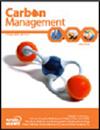贝宁南部阿拉达高原主要土地利用方式的生物量和土壤碳储量
IF 3.2
4区 环境科学与生态学
Q3 ENVIRONMENTAL SCIENCES
引用次数: 3
摘要
非洲生态系统中碳(C)库的清单没有得到很好的记录,尽管它对支持气候减缓政策至关重要。我们量化了贝宁东南部阿拉达高原Ferralsols五种主要土地利用方式(森林、人工林、幼树和成树棕榈林、农田)的植物生物量、木质枯枝、凋落物和土壤(0-30 cm和30-100 cm)中的碳储量。森林的总碳储量(389±54 Mg C ha - 1)高于其他土地利用(人工林、成年棕榈林、幼树棕榈林和农田分别为222±33、154±6、105±2、77±3 Mg C ha - 1)。生物量中的碳储量高于土壤(0 ~ 100 cm),如森林生物量中的碳储量为279±54 Mg C ha−1,土壤中的碳储量为83±2 Mg C ha−1。不同土地利用方式的土壤碳储量差异不大(≈28 Mg C ha−1),且集中在表层土壤。森林的结构和物种多样性部分解释了变异和高于人工林的碳生物量。森林和人工林的类型是保护景观中碳储量的重要因素。本文章由计算机程序翻译,如有差异,请以英文原文为准。
Biomass and soil carbon stocks of the main land use of the Allada Plateau (Southern Benin)
Abstract The inventory of the carbon (C) pools in Africa’s ecosystems is not well documented, although it is crucial to support climate mitigation policies. We quantified the C stocks in plant biomass, woody necromass, litter and soil (0–30 and 30–100 cm) for the five main land uses – forest, tree plantation, young and adult palm groves, croplands – of Ferralsols on the Allada plateau in southeast Benin. Forests have the highest total C stocks (389 ± 54 Mg C ha−1) compared with other land uses (222 ± 33, 154 ± 6, 105 ± 2, 77 ± 3 Mg C ha−1 in tree plantations, adult palm groves, young palm groves and croplands, respectively). The C stocks are higher in the biomass than in the soil (0–100 cm), e.g. in the forest, stocks were 279 ± 54 Mg C ha−1 in the biomass versus 83 ± 2 Mg C ha−1 in the soil. Differences of soil C stocks between land uses are low (≈ 28 Mg C ha−1) and concentrated in topsoils. The structure and species diversity of the forest partly explained the variability and the high C biomass compared to tree plantations. Type of forest and plantations is important to consider in conserving C stocks in landscapes.
求助全文
通过发布文献求助,成功后即可免费获取论文全文。
去求助
来源期刊

Carbon Management
ENVIRONMENTAL SCIENCES-
CiteScore
5.80
自引率
3.20%
发文量
35
期刊介绍:
Carbon Management is a scholarly peer-reviewed forum for insights from the diverse array of disciplines that enhance our understanding of carbon dioxide and other GHG interactions – from biology, ecology, chemistry and engineering to law, policy, economics and sociology.
The core aim of Carbon Management is it to examine the options and mechanisms for mitigating the causes and impacts of climate change, which includes mechanisms for reducing emissions and enhancing the removal of GHGs from the atmosphere, as well as metrics used to measure performance of options and mechanisms resulting from international treaties, domestic policies, local regulations, environmental markets, technologies, industrial efforts and consumer choices.
One key aim of the journal is to catalyse intellectual debate in an inclusive and scientific manner on the practical work of policy implementation related to the long-term effort of managing our global GHG emissions and impacts. Decisions made in the near future will have profound impacts on the global climate and biosphere. Carbon Management delivers research findings in an accessible format to inform decisions in the fields of research, education, management and environmental policy.
 求助内容:
求助内容: 应助结果提醒方式:
应助结果提醒方式:


